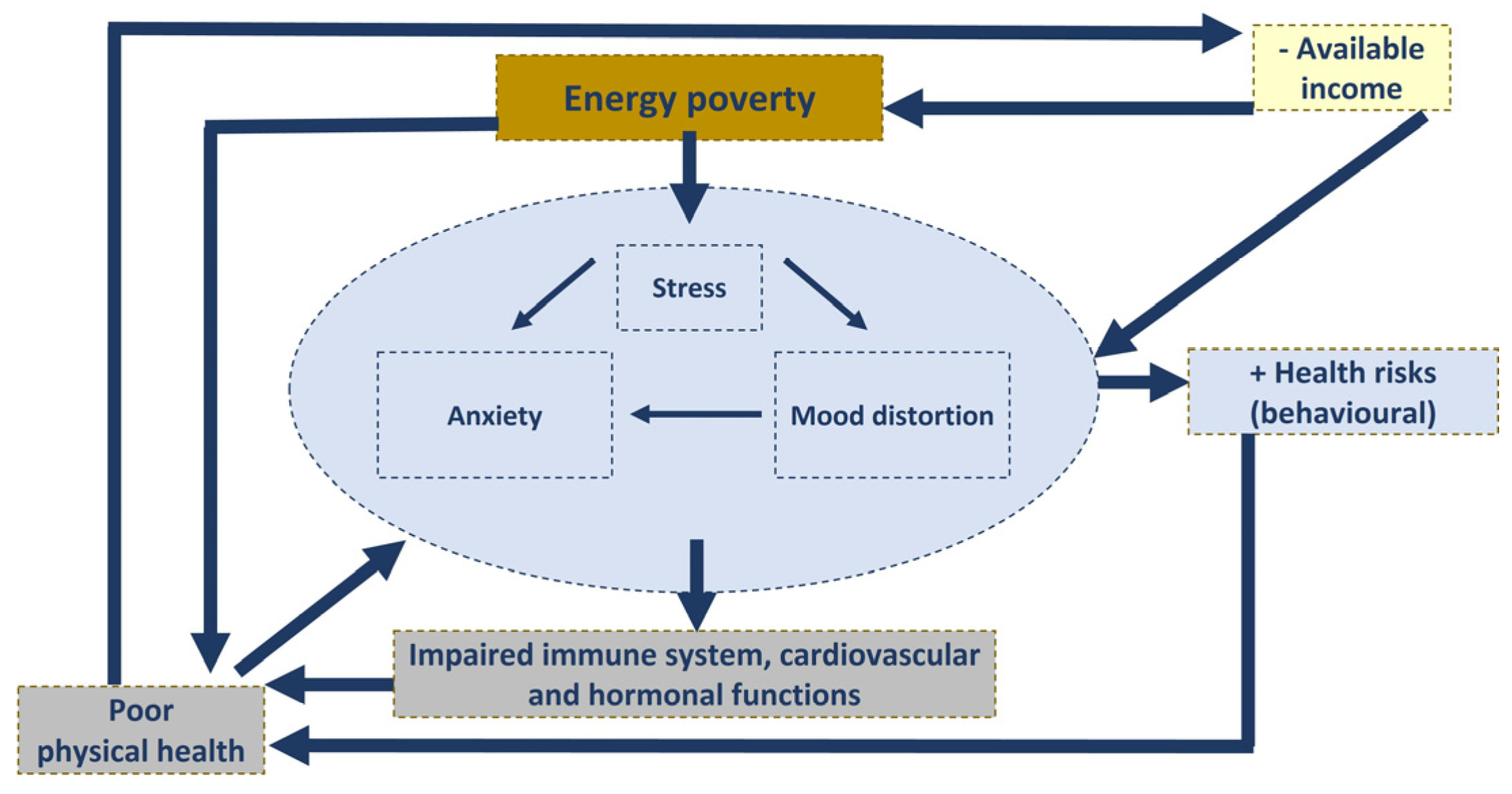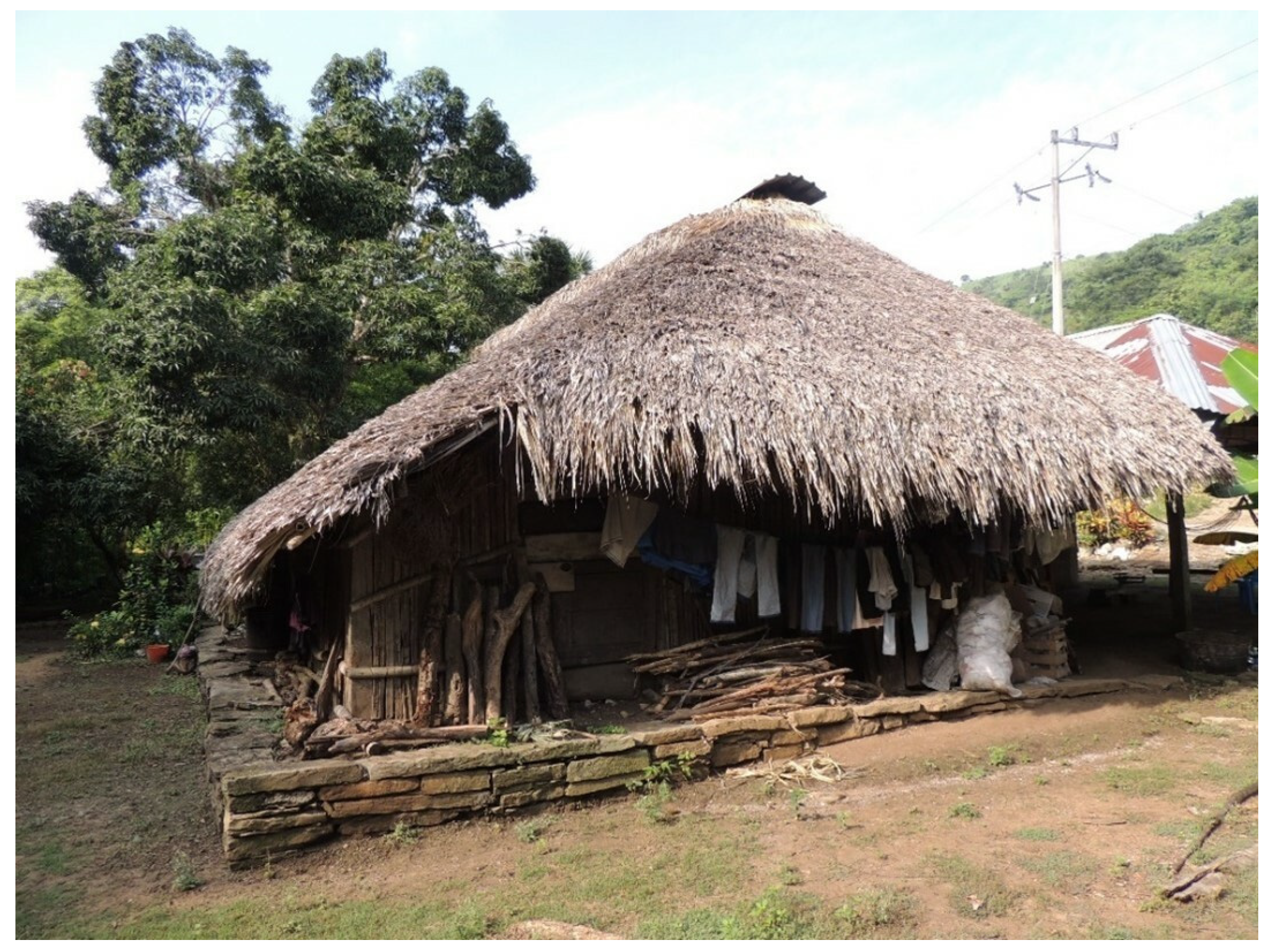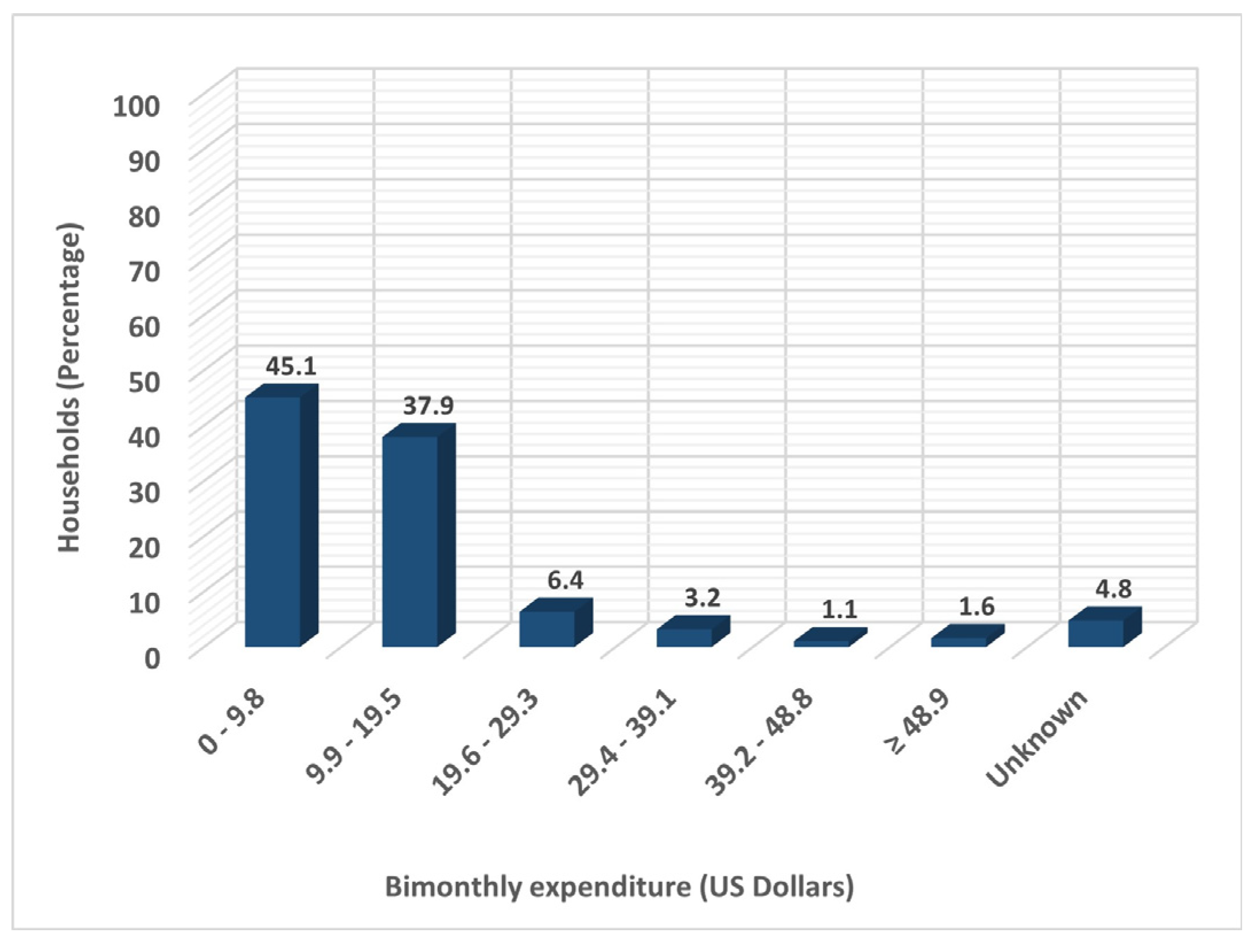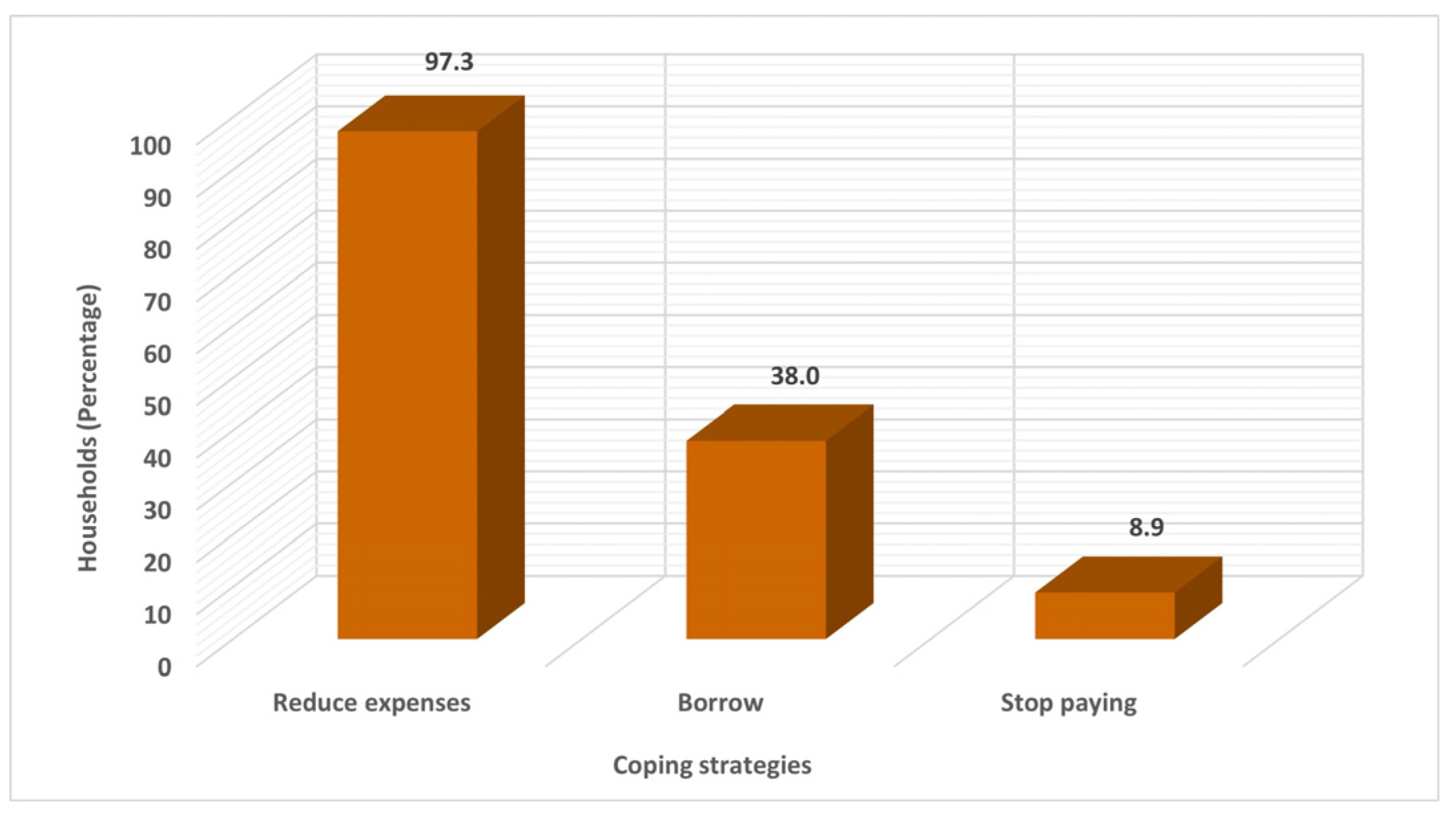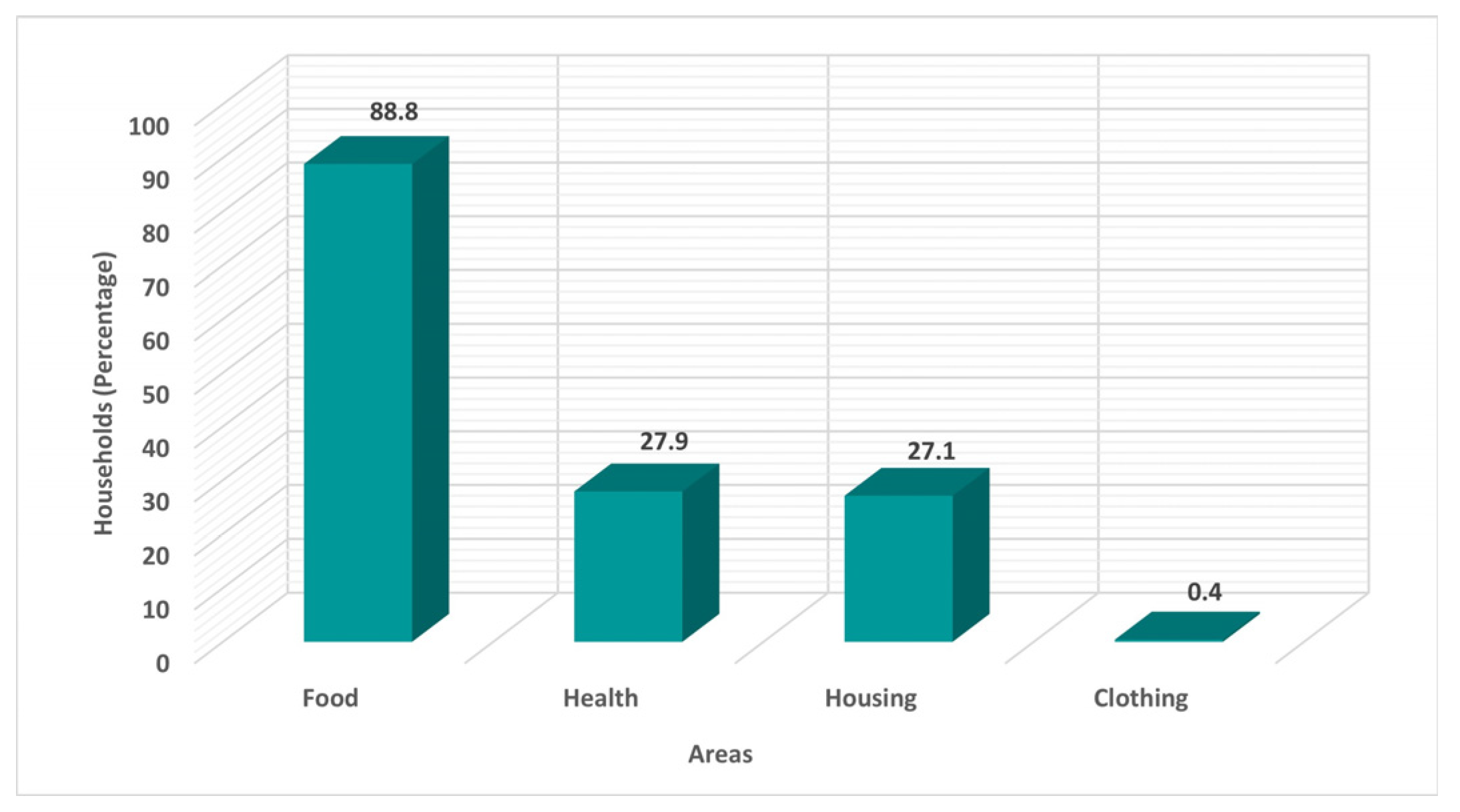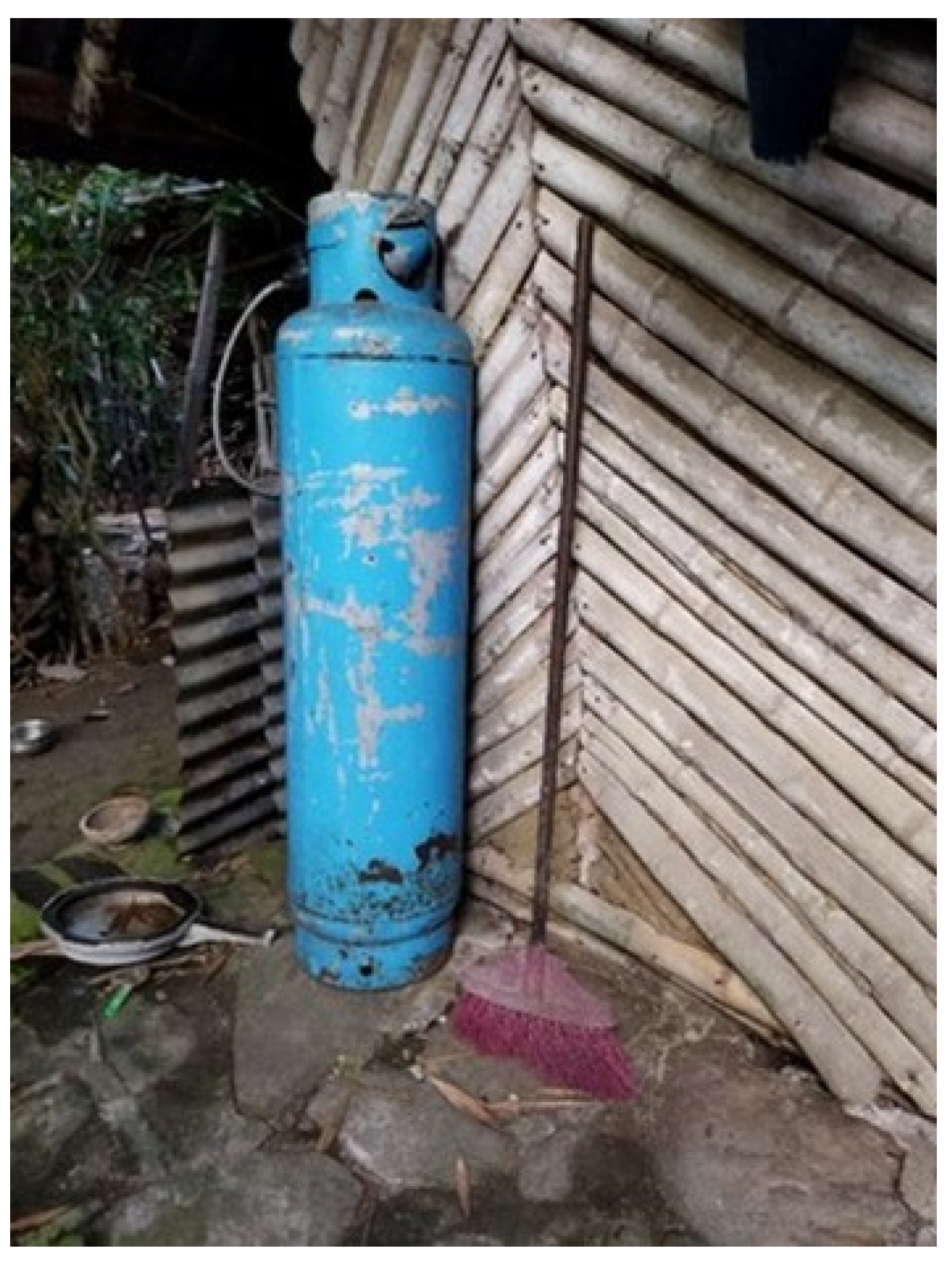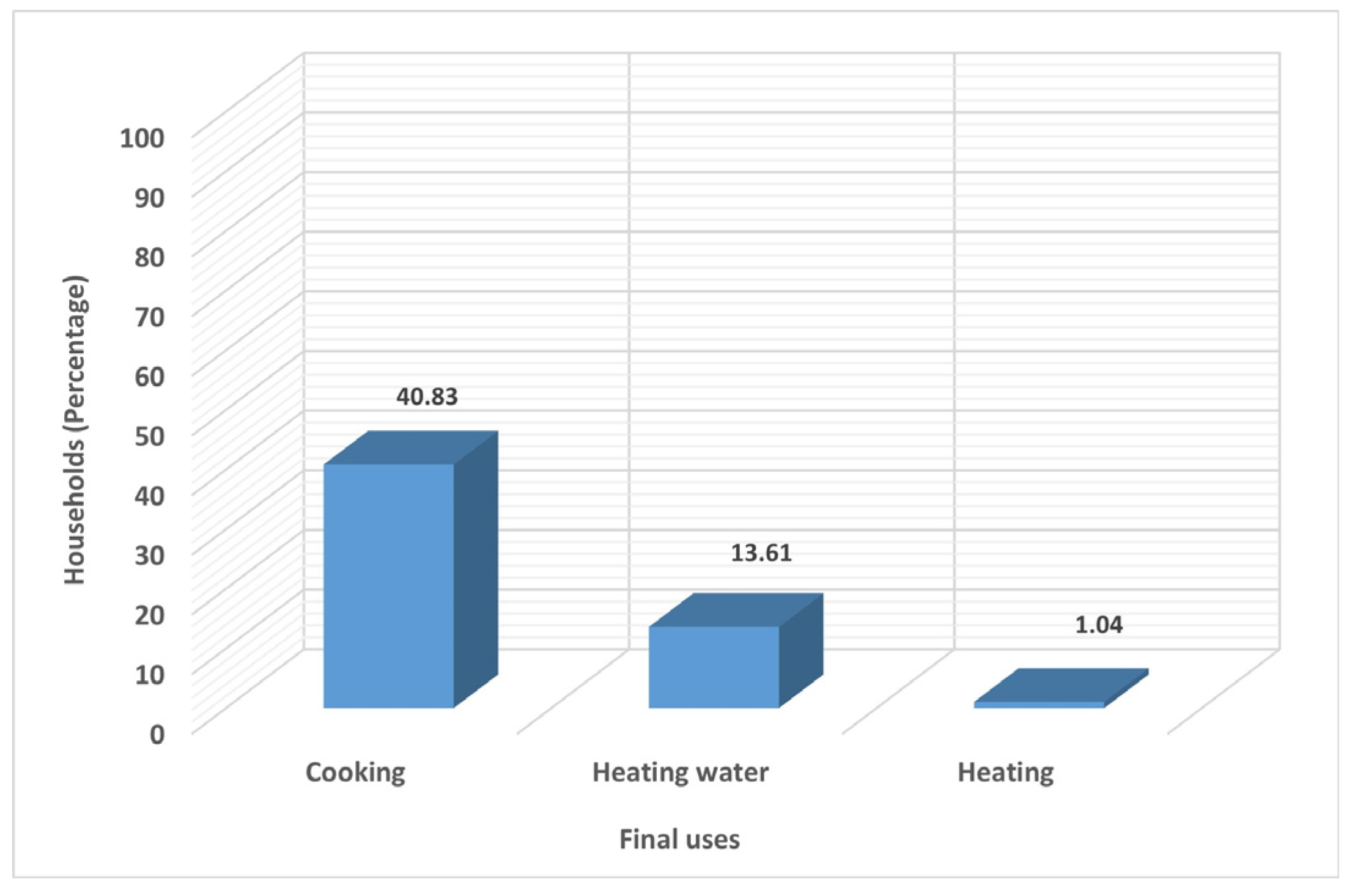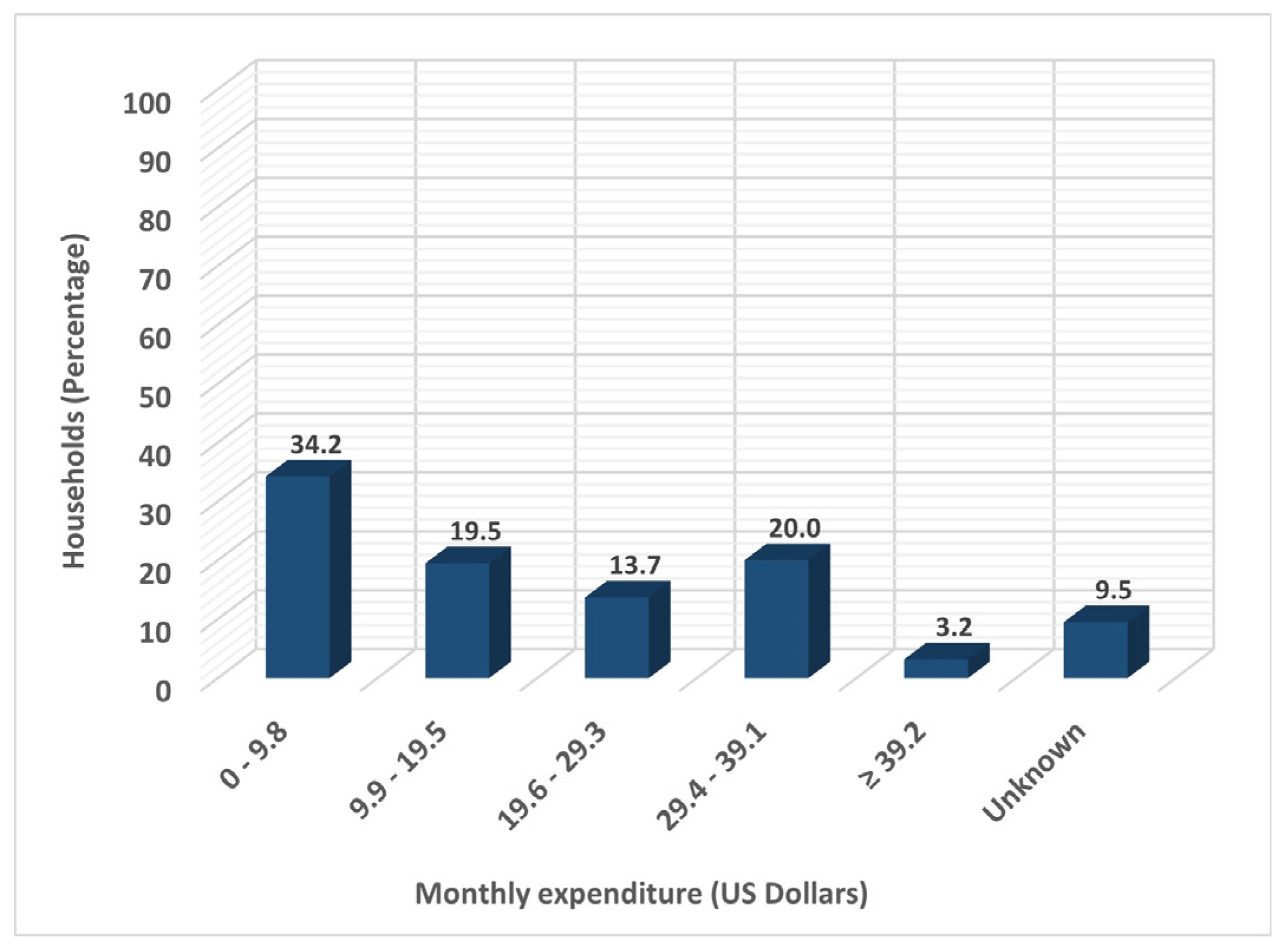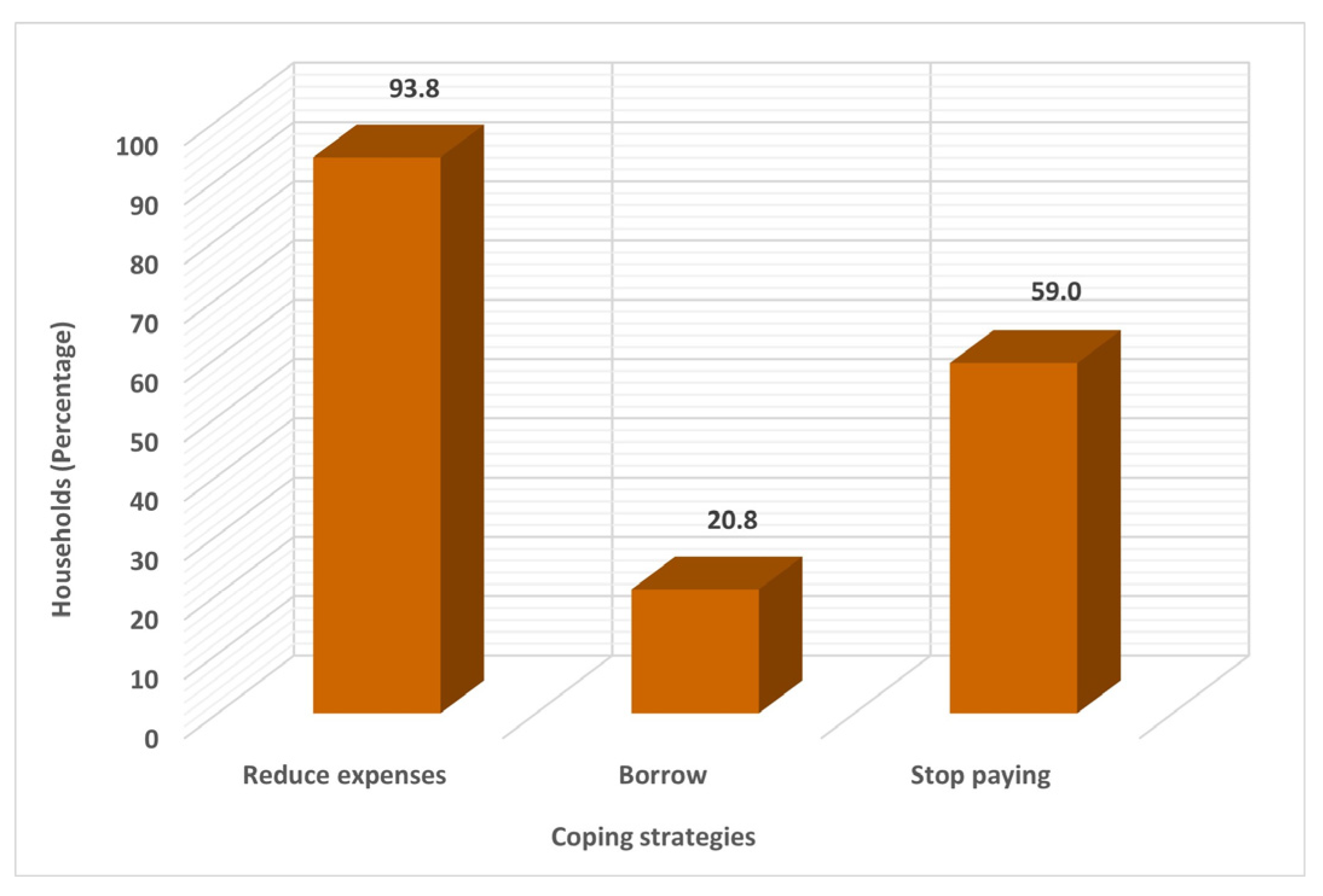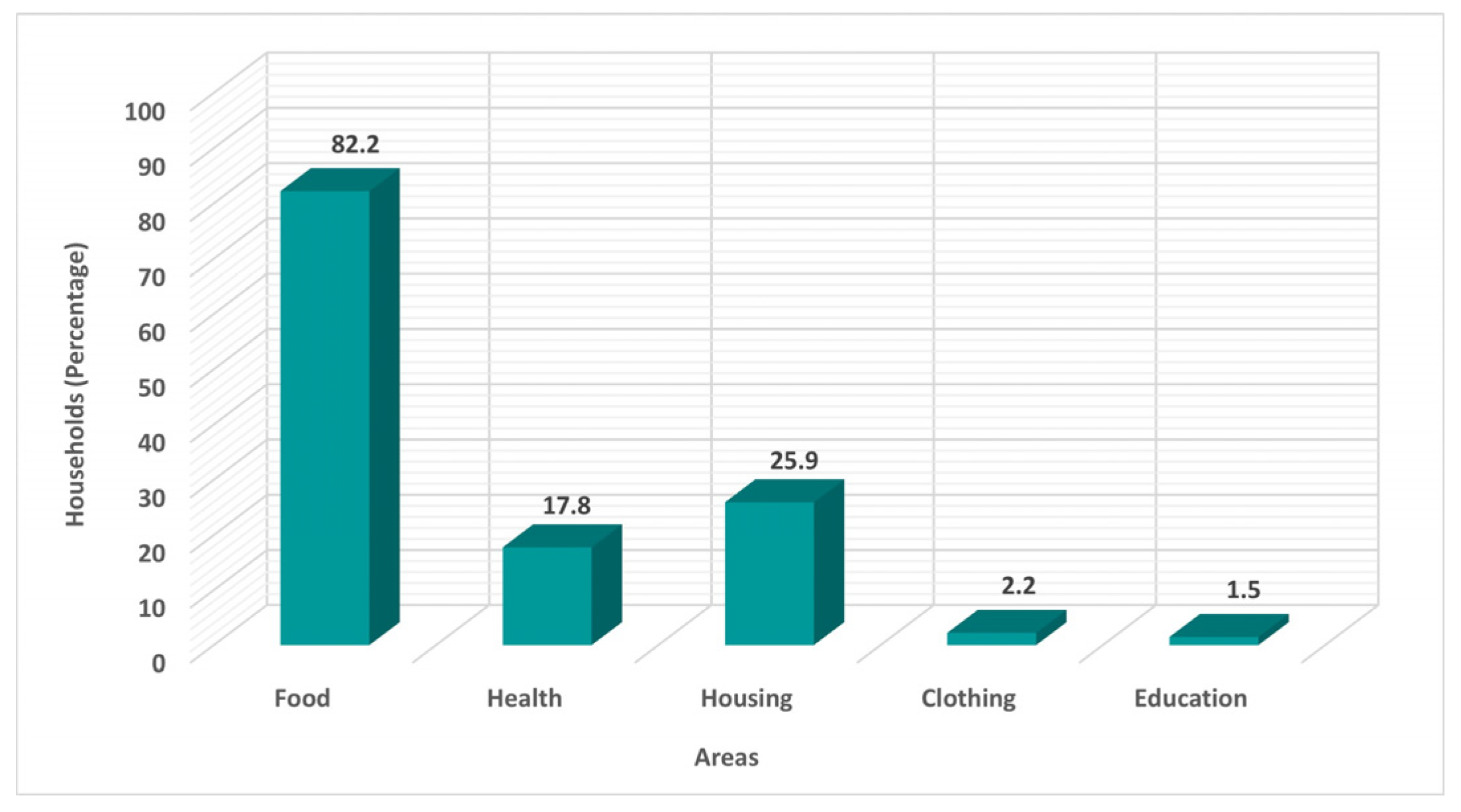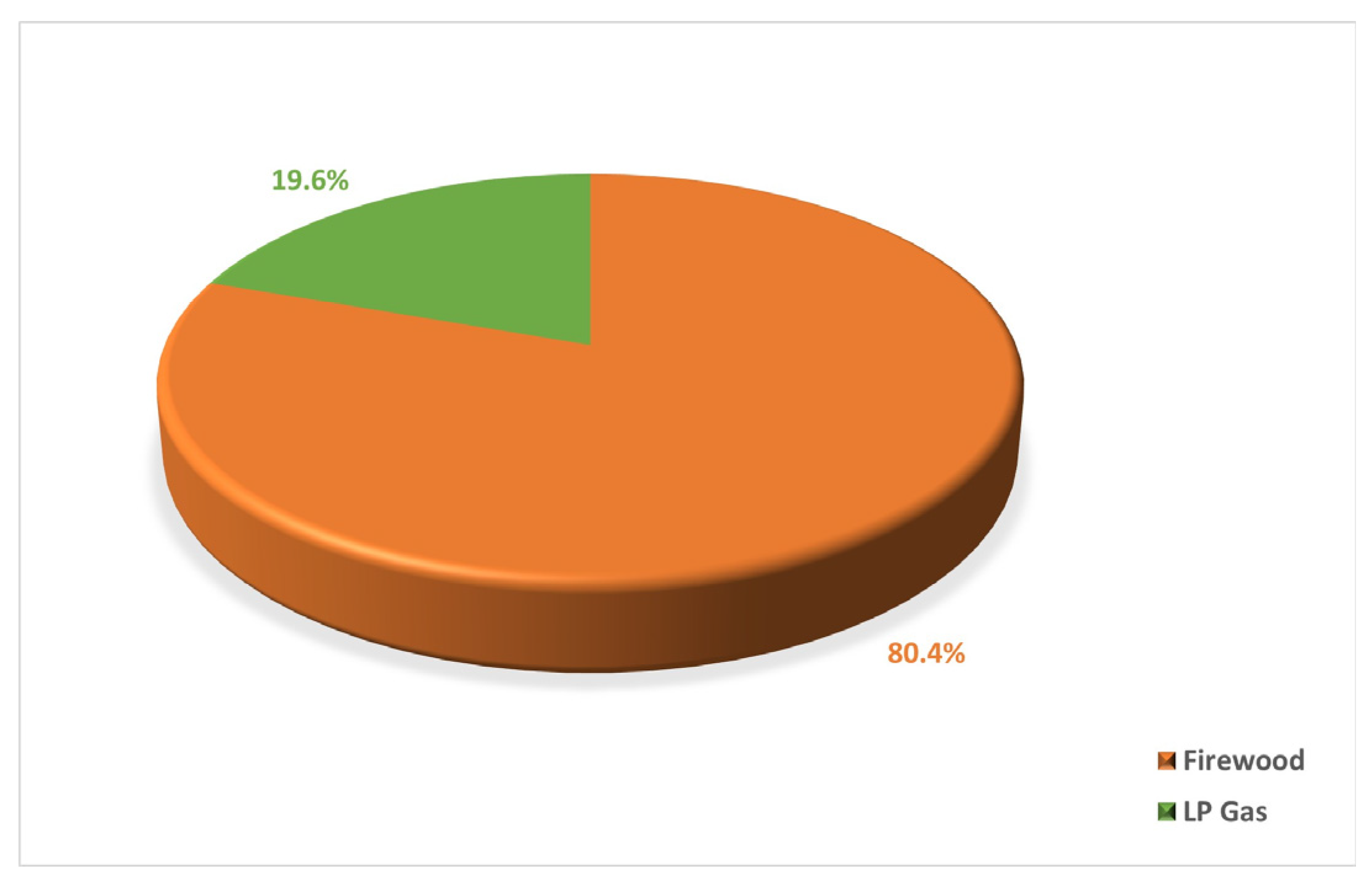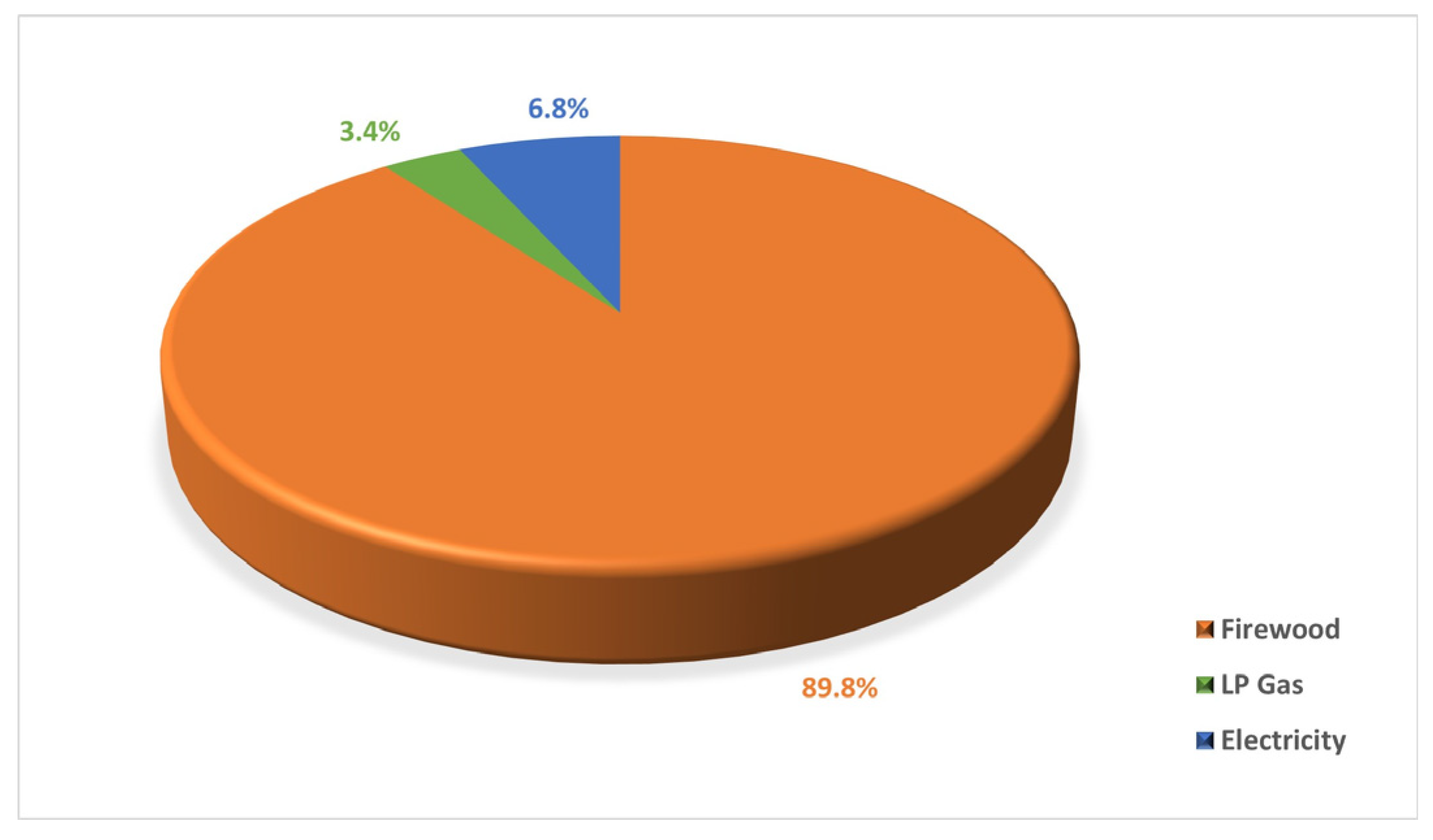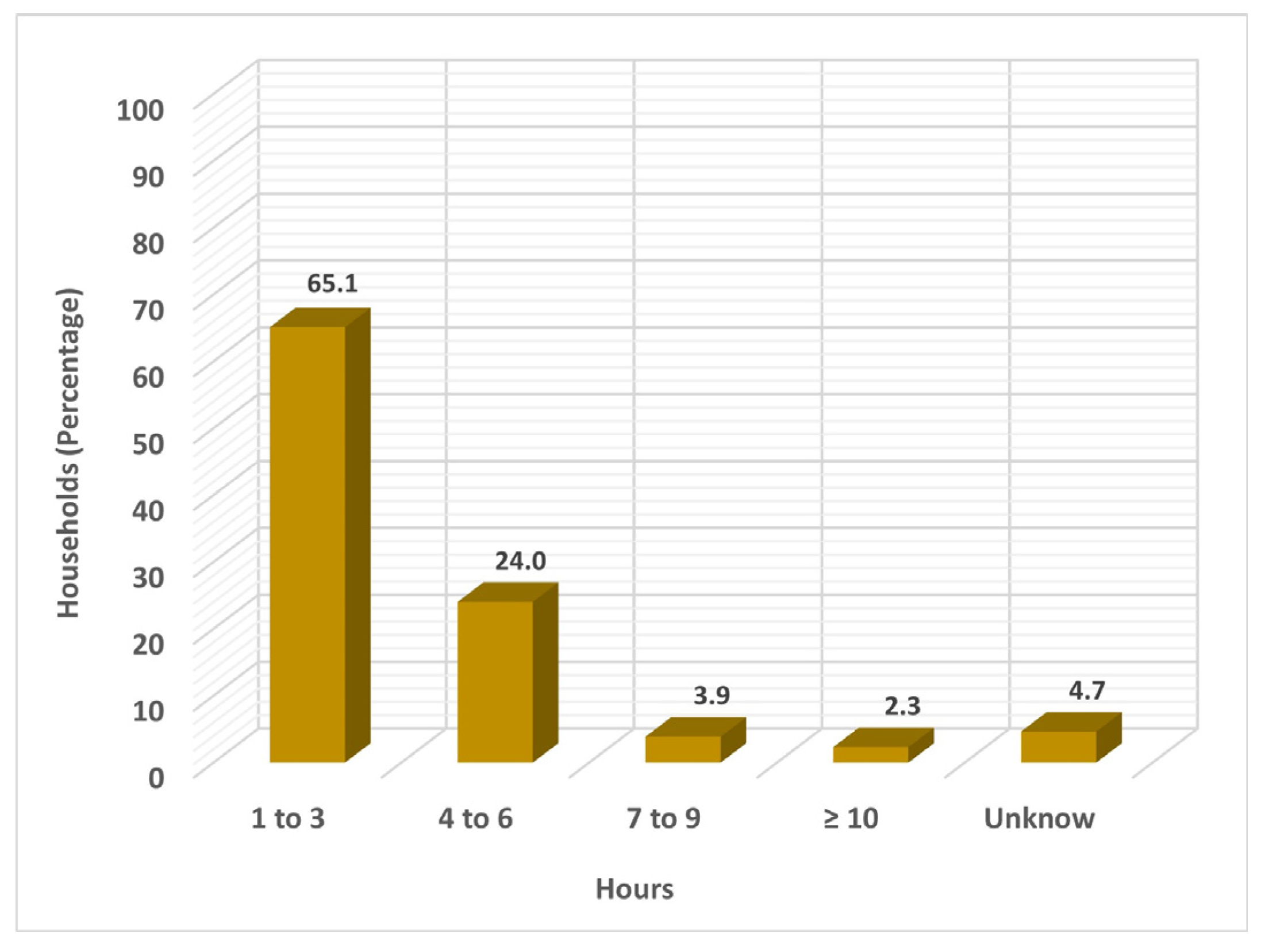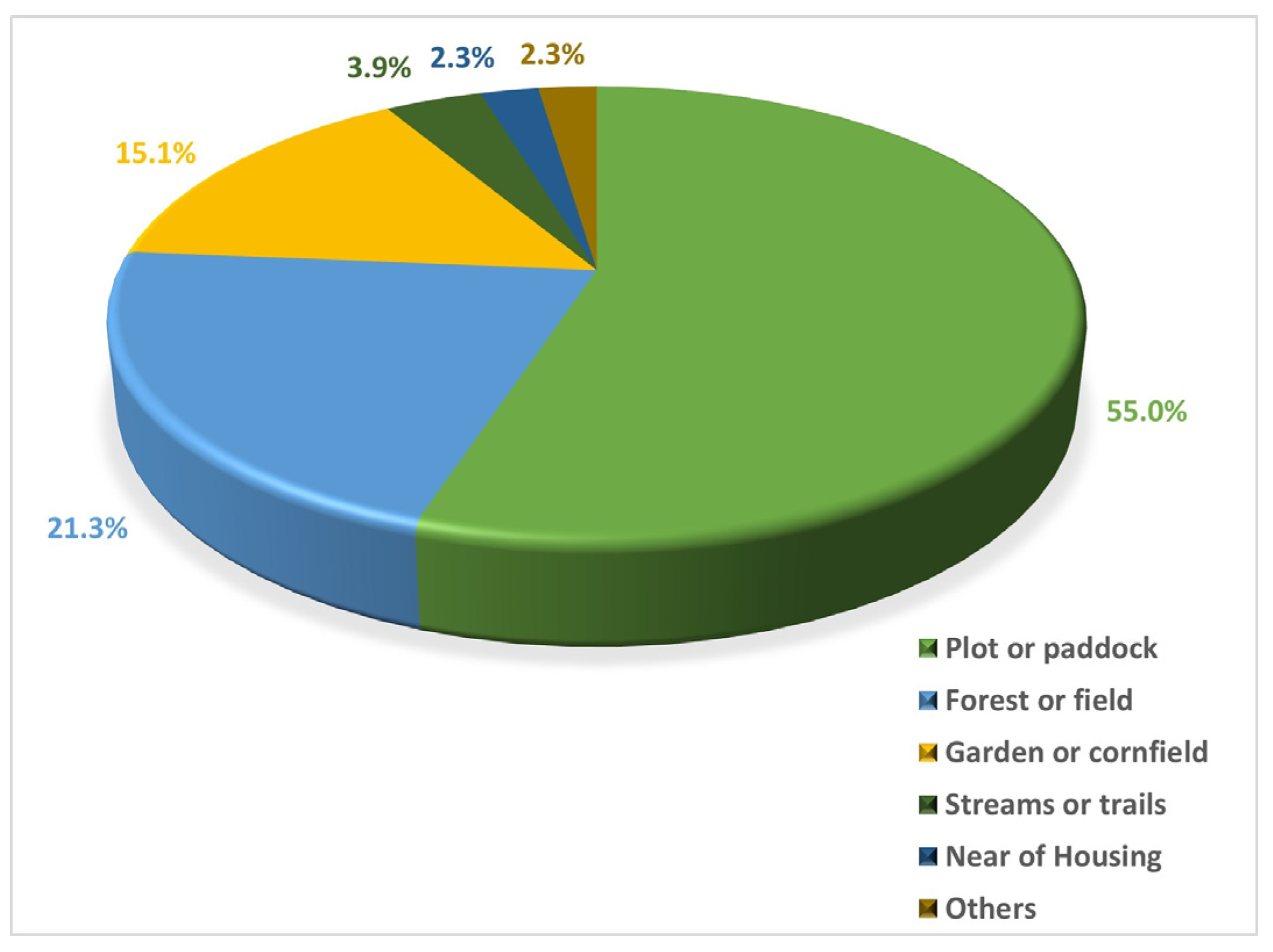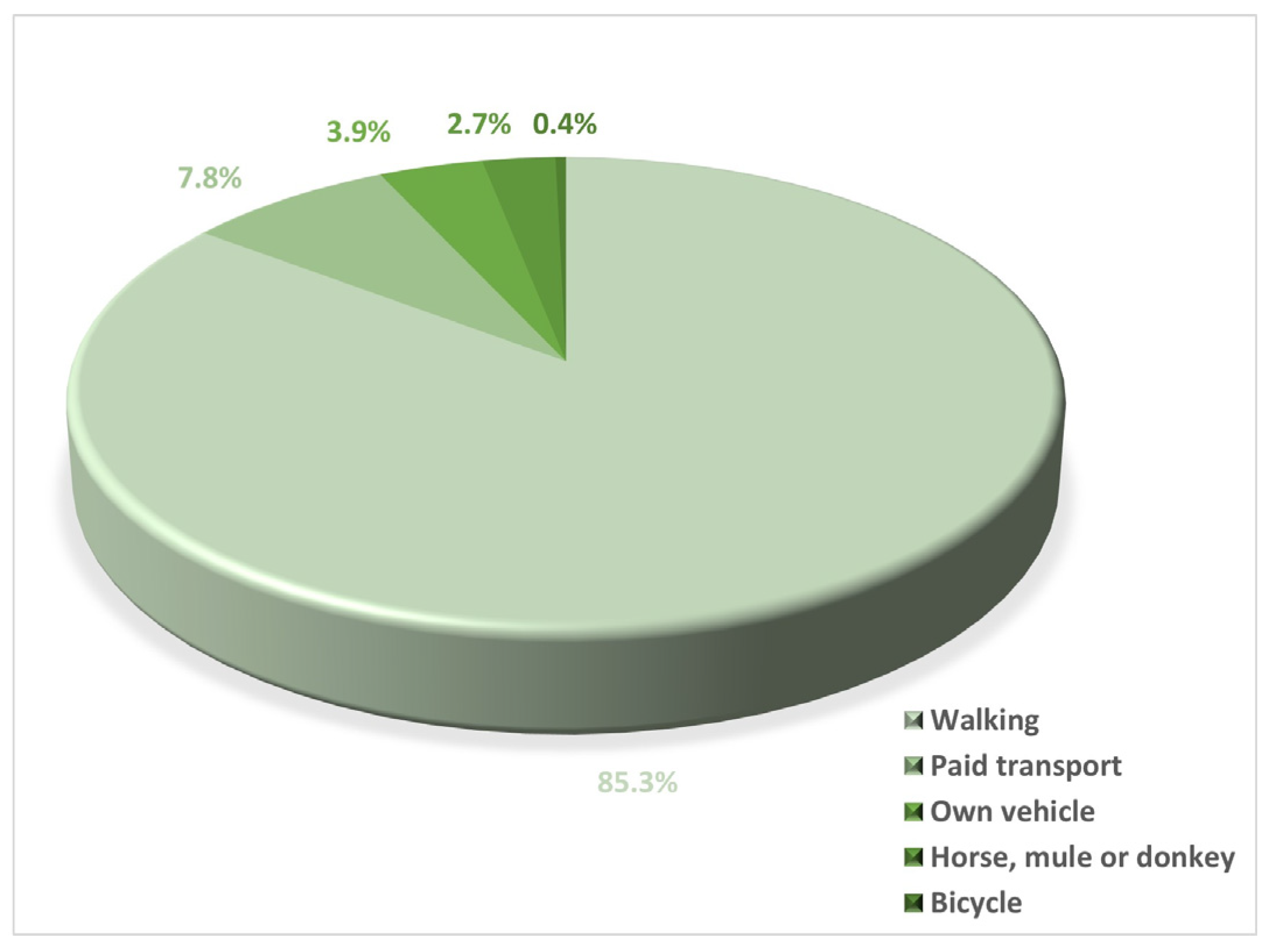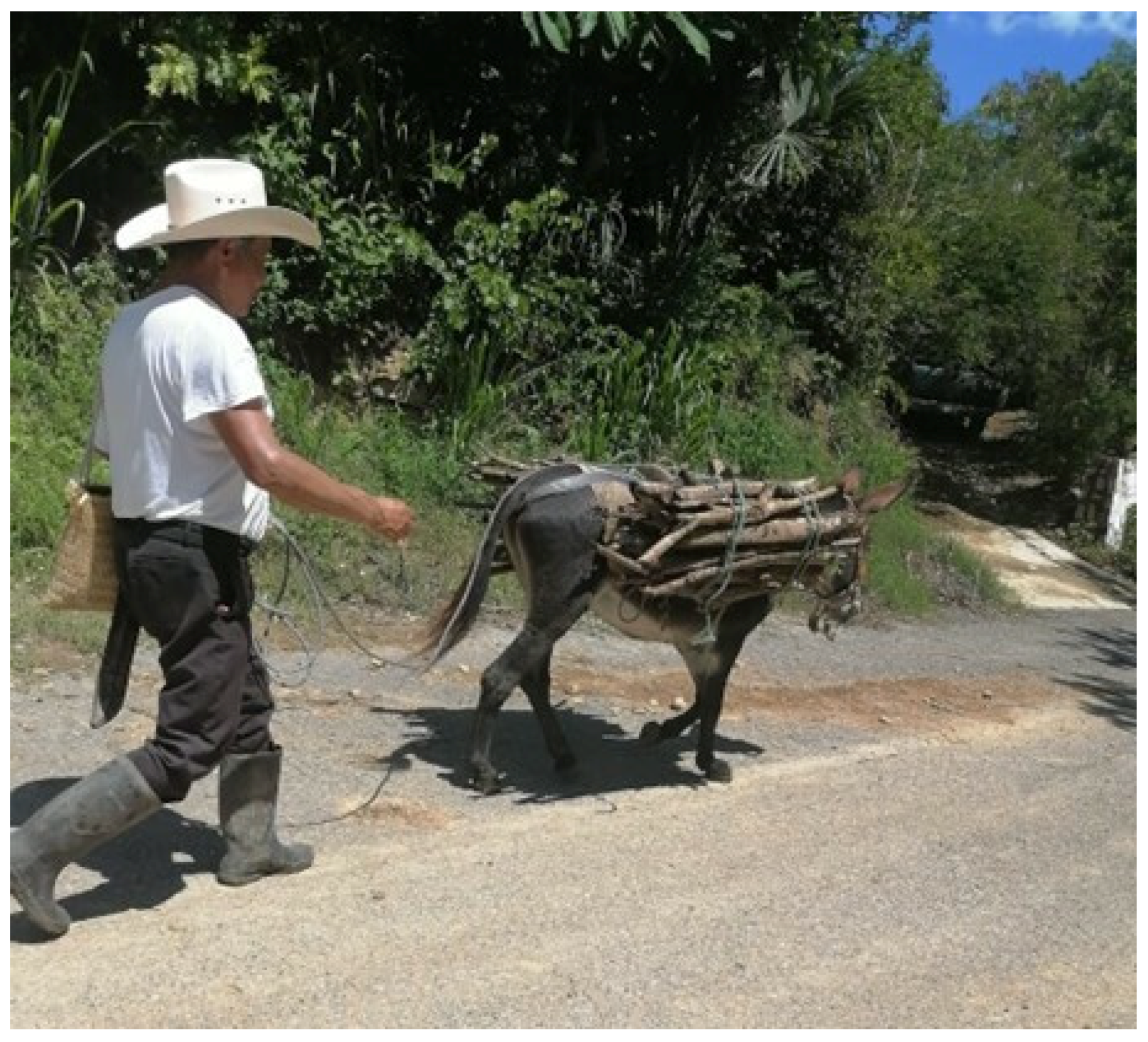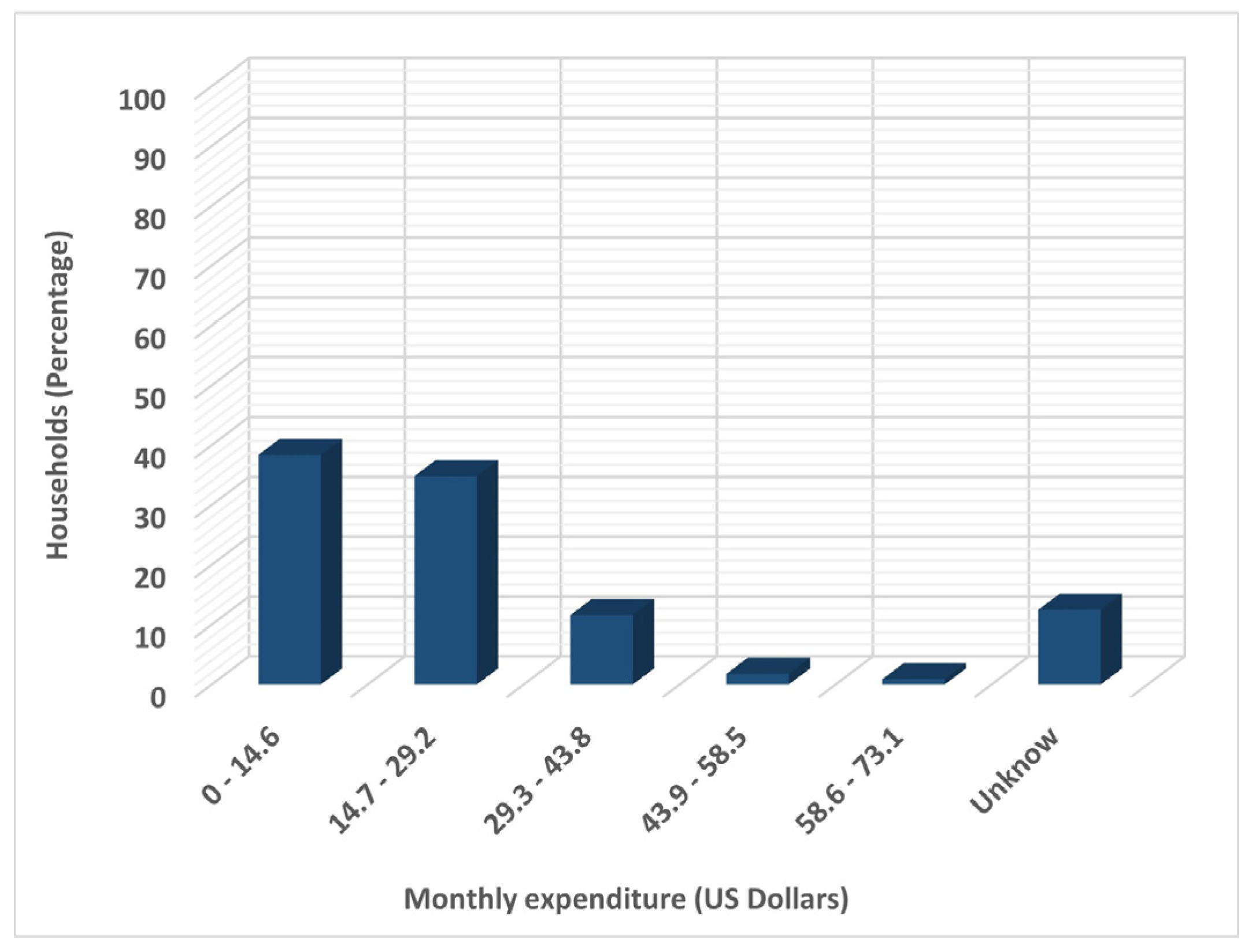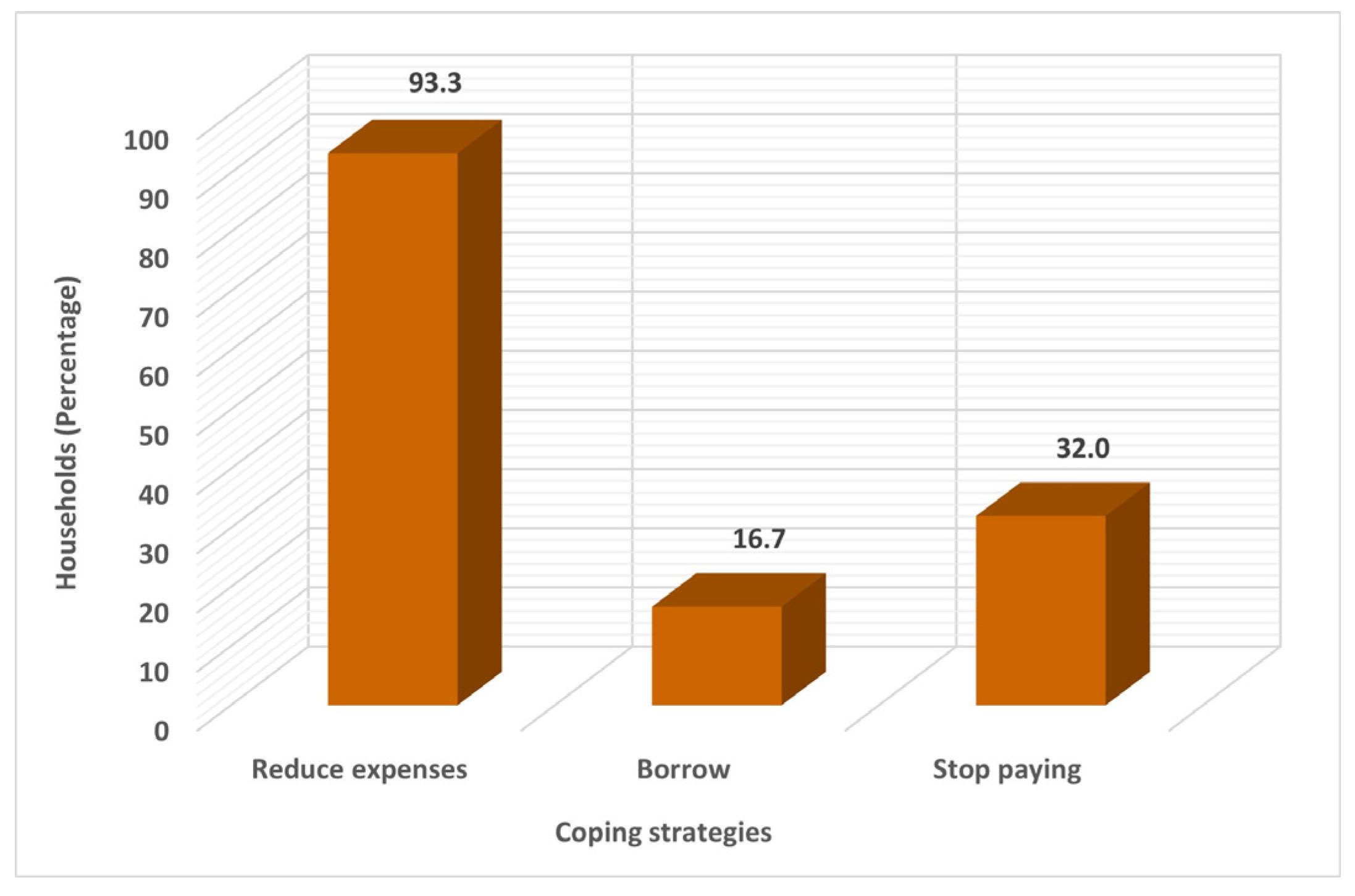1. Introduction
Poverty remains mainly a rural problem, because 80% of the population in poverty still lives in rural areas, particularly in developing countries [
1]. The type of economic activity carried out, the income and its sources, the level of development, infrastructure and services, and the Indigenous population proportion comprise the set of characteristics that, in rural areas, have impacted the prevalence of a higher percentage of the population living in poverty [
2]. Thus, there are differences in poverty according to gender status, ethnicity, age, type of residence according to rural or urban status, and sources of income [
3].
At the global level, the Indigenous population remains predominantly rural [
4] and constitutes one-third of the 900 million extremely poor population in rural areas [
5]. In several Latin American countries, poverty is concentrated in rural areas, and is higher but also more severe for Indigenous communities [
6]. The same applies to the Mexican case [
7], where the Indigenous population is one of the four faces of rural life [
8], the high incidence of poverty occurs mainly in rural Indigenous municipalities, and the rural localities have the highest proportion of Indigenous people living in poverty (78.7%) [
2].
Energy poverty is a social, complex, and multidimensional problem characterized by: (1) lack of access and/or precariousness in the quality of electricity services, (2) difficulties in paying for energy consumption, both electricity and fuels, (3) the lack of access and/or precariousness of energy consumption goods and services to meet the most important human needs, such as food, thermal comfort in the context of heat and cold, lighting, cleaning, and clothing, as well as access to information, communication, and entertainment, and (4) the subjective perception and cultural practices about energy, but also about energy poverty and its impacts [
9].
Studies carried out in Europe show that energy poverty mainly affects people living in rural communities [
10,
11]. However, this trend could be changing, given the current context of the European energy crisis derived from the geopolitical conflict between Russia and Ukraine. According to the International Energy Agency (IEA), as a result of this conflict, the global energy landscape has changed dramatically, with rising prices affecting consumers and focusing the geopolitical context on energy security [
12]. The magnitude and impact of this crisis on the urban context has recently begun to be studied. However, the differentiated impact of this crisis in the rural context and in the Indigenous populations has not yet been analyzed.
Previous studies in the United Kingdom have pointed out a particular vulnerability of rural households to energy poverty, which is due to the difficulty of owning a property, the age and poor efficiency of housing, lack of access to the gas network, the seasonal nature of work, having a low income, and the additional costs of travel to work [
13]. Therefore, rurality is one of the data required to analyze demographic factors in the measurement of energy poverty [
14].
Moreover, rurality is considered a predictor of energy poverty [
15], as well as a predisposing factor for a high rate of energy effort [
16], which refers to the relationship between household income and energy expenditure. However, recently it was recognized that energy poverty is typically experienced in populations with social characteristics linked to other disadvantage [
17].
In this paper, it is argued that rurality is a factor of cumulative vulnerability in energy poverty experienced by Indigenous populations in Mexico.
1.1. Strategies for Coping with Energy Poverty
Although studies on energy poverty began in the 1970s, particularly in the United Kingdom [
18] as a result of the first oil crisis experienced in 1973, the scientific research focusing on coping strategies with energy poverty is more recent. The literature in this regard is not very abundant and is particularly concentrated in the called “Global North” in the decade of 2010 [
17]. This despite the fact that it is precisely in the “Global North” where the issue of energy poverty has had a greater historical development, both at the research level and at the level of policy.
The survival strategies of households vulnerable to energy poverty are complex and multiple. Some coping strategies lead to blockages that further deplete individuals’ resilience reserves, and this makes their coping experience more severe, but the personal and structural blockages determine the choice of survival strategies of these households [
19].
Ways of coping with energy poverty vary enormously. People follow different strategies to inventing solutions and, being forced by the restrictions they experience, find a way to meet at least part of their basic energy needs; most households use one or more of the following strategies: energy efficiency or energy sufficiency, dressing in extra clothes, and using blankets or falling asleep during the day [
20].
Households try to solve the problems caused by energy poverty mainly through three types of coping strategies [
21]:
Reducing their energy consumption (stopping the use of lighting, rationing fuel or disconnecting from services);
Implementing financial measures (including reducing their food expenditure);
Going into debt.
Unusually cold weather causes budget crises that impact unequally on American families, with the poorest families being the most affected because they often lack savings, current accounts, or access to short-term credit, loans, or savings investments to cover increases in fuel costs; as a result, they are forced to choose between heating their homes and feeding themselves and their children [
22]. They may increase their expenditure on fuel in order to heat the household and reduce their expenditure on food and nutritional welfare in equal proportion, eating less food and reducing caloric intake in both children and adults [
22].
In the United Kingdom, low-income households cannot heat housing as they would like during the winter, so as coping strategies they reduce heating, they use it intermittently or restrict it to priority moments during the day or to specific rooms in which they limit their domestic life, they also use blankets and wear extra clothes, they go to sleep earlier, increase their debts by borrowing from friends and family, buying goods on special offers and, in some cases, trying to find lower energy prices [
23].
The summarized research findings point out the strategies used by the population to cope with energy poverty in the “Global North”, in countries whose greatest challenge on the subject is the cold climate [
17] (p. 6):
Use extra clothing and ration the heating of the house;
Self-disconnection of services and leave to warm up;
Restrict the use of heating of the house, turning it on only for visitors or for certain family members, or only in one of the rooms and during the winter;
Sleeping during the day in the winter season;
Using public buildings to shelter and stay warm.
1.2. The Energy Poverty Impacts
Poverty affects mental processes, generates stress, and makes people take decisions against their interests overall, since the attention of people experiencing economic adversities is focused on addressing these adversities in the short term, rather than planning ahead [
24]. The fight against fuel poverty seems to be associated with a more specific domain of mental health: anxiety, mood, and coping strategies [
25].
With energy poverty and the need to cope with it, life becomes misery, while physical health problems worsen, and social isolation is exacerbated [
23].
Reducing other household expenditures is common as a strategy to address energy poverty, including the food budget, particularly in single-parent households; causing long-term effects on physical health, associated with deficient diets and low nutritional value, in addition to increased stress, and a restriction of social activities that can lead to loss of self-esteem and depression [
21].
Disconnections from energy services have multiple direct consequences (lack of electricity and/or heating, and additional costs) indirect consequences (such as food spoilage) and subjective consequences (as feelings of shame, insomnia, and despair at the inability to maintain a dignified life with access to basic services) [
20].
The hypothetical cycle of risk due to living in energy poverty (
Figure 1), particularly when living in a cold and wet house, shows the direct deficiencies produced in physical health, and coping strategies reinforce the concerns and components that lead to negative human well-being (stress, anxiety, mood distortion), cyclically affecting the immune system and physical health (originally deficient due to energy poverty) [
26].
Households that adopt fuel rationing and insufficient heating as strategies to cope with energy poverty present a greater risk of physical impacts including cardiovascular and respiratory problems; they may also experience stress, configuring mental health problems and depression: people often feel unable to have guests in their home, limiting their relationships, and this in the long term can have consequences for mental health [
21].
1.3. The Relevance of Analyzing the Strategies to Cope with Energy Poverty
From a global perspective, the destruction of the natural environment and damage to human health caused by greenhouse gases, toxic smoke, and dust due to the use of fossil energy is increasingly significant, so there is an urgent call to replace traditional fossil fuels [
27]. In addition, to achieve the 2030 Agenda for Sustainable Development, the international community urgently needs to reconsider rural development [
1].
In this context, renewable energy generation—such as of solar and wind energy, which will surely become the main energy sources of future energy strategy [
28]—could contribute to significantly reducing energy poverty. This is because energy services are of crucial importance in supporting economic growth and energy policies to combat inequality in human well-being, so that no country has achieved sustained economic growth without improving both access to cleaner and more modern forms of energy and the services provided [
29]. However, the impact of the implementation of clean energy (including bioenergy) to address energy poverty in a sustainable way over time has not been explored in the rural Indigenous populations.
People living in poverty adopt all kinds of strategies to mitigate and cope with it [
3]. Nevertheless, there is a very notable gap in the scientific literature about strategies to cope with energy poverty. Studies in the field are really just starting in European countries—despite its long tradition in studies on energy poverty—but for Latin America and Mexico, these studies are even more scarce and are particularly inexistent for the Indigenous populations case.
The financial conditions and ways in which energy costs are addressed are decisive factors in energy poverty, but have remained forgotten in scientific research [
20]. In addition, minority groups and households living in rural areas are underrepresented in studies on strategies to tackle energy poverty, although it is in these groups that energy poverty is significantly prevalent. For this reason, there is very little evidence on how these groups cope with energy poverty [
21].
Therefore, the objective of this paper was to analyze the strategies used by the rural Indigenous populations to cope with energy poverty, focusing on the State of San Luis Potosí, Mexico.
Two groups of questions guided this work:
Does the rural Indigenous population of the State of San Luis Potosí, Mexico, have access to domestic energy (electricity and fuels)? If so, to what extent, with what characteristics, and with what quality?
Does this population experience difficulties paying for energy consumption, both electricity and fuels? If so, what kind of difficulties and how does this population face these difficulties?
The hypothesis was that the Indigenous population of the five rural municipalities with the largest Indigenous component and multidimensional poverty of the State of San Luis Potosí, Mexico experiences an exacerbated energy poverty, mobilizing several coping strategies.
This work contributes to: (1) identifying and characterizing the strategies to cope with energy poverty used by the Mexican rural Indigenous population; (2) filling the gaps in the literature in this area by providing original scientific knowledge based on primary data and collected for this purpose; (3) mobilizing debate on a complex and multidimensional social problem that affects the Indigenous populations of Mexico in an unequal manner, and is exacerbated by gender, age, and rural conditions; and (4) delineating thematic axes with potential to be included in policy for reducing this problem and its impacts.
Therefore, this paper sets a precedent in studies on the strategies used by Indigenous populations in rural municipalities to cope with energy poverty they experience.
The content of this paper is organized as follows:
Section 2. Methodology explains the research scenario, and the route of data collection and analysis,
Section 3. Results and Discussion presents the main research findings, taking up available studies on the subject, and finally the Conclusions section reflects on the contribution, scope, and implications of the study.
2. Methodology
This paper aimed to analyze the strategies used by the rural Indigenous population to cope with energy poverty, focusing on the State of San Luis Potosí, Mexico. The results presented derive from the project “Measuring energy poverty and its health impacts on selected Indigenous communities in the State of San Luis Potosi, Mexico: While developing public policy to promote renewable energy” carried out from March 2021 to March 2022 in the five municipalities of the State of San Luis Potosí, Mexico, with higher rates of multidimensional poverty and high Indigenous population (
Table 1), namely San Antonio, Tanlajás, Coxcatlán, Xilitla, and San Martín Chalchicuautla, which are located in the geographical–cultural region called the “Huasteca Potosina”.
Due to their high Indigenous population, these five municipalities are officially classified as “Indigenous municipalities” (National Commission for the Development of Indigenous Peoples [CDI], 2017) [
33] and were recognized as “Rural Priority Areas of Attention” (
Table 2) by the Mexican federal government [
34,
35] for having a high degree of marginalization, a social lag that goes from high to medium levels, a significant percentage of people in extreme poverty, being Indigenous municipalities, a level of crime that begins to increase, besides being rural municipalities.
To collect data, a questionnaire-type instrument was designed, including a section on the characterization of energy poverty and the strategies used by the population to cope with it. The instrument was validated by content and construct. Thus, based on a broad review of the literature, prior knowledge of the research scenario, and subsequent analysis of both, a matrix with the analytic framework was constructed (
Table 3) which integrates all the components of the content domain of the variables present in the phenomenon, as well as the relationship between them. The variables, and their relationships, were directly operationalized as questions in the questionnaire-type instrument.
This instrument was then applied to a probabilistic sample, to which was added 5% as replacements, obtaining a total of 398 dwellings, taking as a selection unit the households of these dwellings and their habitual residents, and as an appropriate informant the head of the household or the spouse of the head of the household, and in their absence an adult inhabitant who knew the requested information.
The administration of questionnaires was conducted through a face-to-face interview, for which 15 teachers and 3 community managers, all bilingual, native to the region and working in the selected municipalities, were recruited and trained. The data collection was conducted during September–October 2021, by random route sampling, proceeding to its analysis, validation, and capture. Data analysis was performed using the Microsoft Excel program, Version 2304, obtaining descriptive statistics.
The results of the strategies used by the population to cope with energy poverty in the five rural Indigenous municipalities studied are presented below, contextualizing research findings in the frame of available studies on the subject.
3. Results and Discussion
The gender distribution in the households of the Indigenous municipalities studied shows that 48.1% were men and 51.9% were women. Schooling was concentrated mainly at elementary school (35.4%) and at middle school (34.3%) levels, with a lower proportion at the Baccalaureate (16.7%) and university level (6.7%).
The income of these households came mainly from work (85.6%), usually performed by only one member of the family. However, there was also income from federal social programs (11.8%), remittances sent by relatives from abroad (1.3%), and other unspecified sources (1.3%).
A fifth (20.1%) of the population had an income equivalent to USD 1.6 per day, while 33.3% had an income equivalent to USD 3.2 per day and 19.6% had a daily income equivalent to USD 4.8 per day (
Table 4). These groups added together accounted for 73% of the total population.
In addition, 23.7% of households had debts, allocating significant amounts of their monthly household income to paying these. According to the literature, indebted households tend to be the youngest, with children, with handicapped or a chronic terminal illness, and in many cases, debt is a cause of mental health problems and family breakdowns, generating greater stress, loss of self-esteem, and guilt [
21].
In this regard, it can be emphasized that about 20.1% of the population studied had an income below the extreme poverty line established by the World Bank, which is USD 1.90 per day per person, while about 73% of the population studied had an income that was below the poverty line established by the Inter-American Development Bank, which was USD 5.00 per day per person [
46]. However, while the poverty thresholds set by international organizations refer to the daily income per person, the referred income for the studied population was usually obtained by a single person but used for all members of the household, being mostly the only source of income, and a household of the rural Indigenous municipalities studied had on average four inhabitants [
47]. Thus, poverty in the rural Indigenous households studied was more severe than these international thresholds indicate.
In Mexico, the states with the largest Indigenous population have the lowest income indicators, but in the rural context the situation worsens because there the population has income below 50% of the income of the urban population in the same entities [
9].
Thus, the households studied had an extremely low income, leaving little room for maneuver in their daily budget, so it is possible that they were forced to cope with energy poverty by sacrificing other areas of the family budget, originally allocated for other daily needs, as the literature has shown for other cases [
23].
3.1. Electricity: From Access to the Accessibility Gap
In the rural Indigenous municipalities studied, 95.7% of households had access to electricity through connection to the public grid (
Figure 2), while 4.0% did not have access to electricity through connection to the public grid but neither did they have access to another source of electrical energy, while 0.3% did not have access to electricity through connection to the public grid but used other sources to address the situation, mainly by lighting homes with candles and, in some cases, by combining the use of candles with battery-operated hand lamps.
These results on access to electricity through connection to the public grid are consistent with the disaggregated official data [
47] for the rural Indigenous municipalities studied (San Antonio 95%, Tanlajás 95.8%, Coxcatlán 95.8%, Xilitla 95.7%, and San Martín Chalchicuautla 97.6%) and are slightly lower than those reported for the Municipality of San Luis Potosí, which (being the most urbanized municipality and capital of the State of San Luis Potosí) has a lower proportion of the Indigenous population (0.54%) and an access rate to electricity of 99.6%. These results contrast with the IEA [
29] figures, because no significant differences were found in access to electricity between rural and urban municipalities.
Of the households that had access to electricity through connection to the public grid, 94.7% did not know their electricity tariff, while only 82.7% had their own electricity meter, so the rest of the households (17.3%) did not have the ability to monitor their energy consumption, nor payments for the service used.
A little less than a half (45.1%) of households spent up to USD 9.8 to pay their bimonthly electricity bill, 37.9% spent from USD 9.9 to 19.5, while 6.4% spent from USD 19.6 to 29.3, and 3.2% spent from USD 29.4 to 39.1, accounting for 89% of the population with access to electricity through connection to the public grid (
Figure 3). The literature shows that in Mexico there is a close relationship between income and electricity consumption, and the households of lower social strata spend a higher proportion of their income on electricity consumption [
48].
Of indigenous households with access to electricity through connection to the public grid, 43.9% described having difficulty paying for electricity consumption, while 89.7% reported power outages, and 32.4% had received excessive charges on their electricity bill.
However, the deeper results show that the total number of households with difficulties paying for electricity consumption was greater than 43.9%, given that 67.7% of households with access to electricity through connection to the public grid used various coping strategies to face their difficulties in paying for electricity consumption. Thus, of the households that used coping strategies, 97.3% had to reduce their expenses or stop buying other things to pay for electricity consumption, 38% had to borrow money in order to pay electricity consumption and 8.9% stopped paying electricity bills due to lack of economic resources (
Figure 4). Additionally, 4.6% of households had to use all three coping strategies mentioned above.
Of the households that reduced their expenses or stopped buying other things as a coping strategy to pay for electricity consumption, 88.8% reduced their expenses or stopped buying things in the food area, while 27.9% reduced their expenses or stopped buying things in health area, 27.1% reduced their expenses or stopped buying things in the housing area, and 0.4% reduced their expenses or stopped buying in the clothing area (
Figure 5).
It should be noted that in this group of households that reduced their expenses or stopped buying other things as a coping strategy to pay for electricity consumption, 73.5% did so in a single area (73.0% in food and 0.5 in clothing), while 4.0% made cuts in two areas (food and housing), 12.1% in three areas (food, health, and housing), and 0.5% in four areas (food, health, housing, and reducing travel).
Likewise, from the group of households that stopped paying electricity as a coping strategy, almost a quarter (26.1%) had the electricity service cut off due to non-payment and it took from 2 days to several weeks for these households to have electricity service again.
These results coincide with those in the literature, which highlight that when households struggle to pay for their energy consumption and fight to avoid being disconnected from the grid, they can accumulate debts and sacrifice their food expenses [
17]. Thus, two-thirds of the population perceive energy expenditure as a burden, while households living in poverty often display fragile financial management and as coping strategies selectively use lighting resources, illuminate with television, or illuminate only a room [
20].
Given the results, it is important to underline here that there is a difference between access and accessibility to electricity because a high degree of electrical coverage (access) does not necessarily imply reaching significant levels of consumption (accessibility) [
6], nor that this electricity consumption can be easily paid for.
Studies show that when there is an electricity payment deficit there are subsequent power outages. Often debts are settled within a few days after disconnection and services are restored, but sometimes the budgetary crisis persists and the household continues with a power service cut and, in most extreme cases, this situation could even last several years [
20].
Thus, the measures to reduce household energy spending include facilities or improvements in energy efficiency, as well as reducing spending in other areas of the household budget and, in some cases, not using lighting [
21]. For lower-income households, the food budget is the only area of spending in which to be flexible and make reductions without falling behind; in these cases, parents report that food has been reduced in order to give priority to the needs of their children, but this is a problem that is aggravated in population groups who spend longer periods at home, such as pensioners, and persons with disabilities or diseases [
21].
3.2. The Use of Domestic Fuels
3.2.1. LP Gas: The Gap towards an Energy Transition
Of households in the rural Indigenous municipalities, 47.9% of those studied used LP gas, but not all of this group used it as a main fuel and neither did they use it continuously over time (
Figure 6). In this group, cooking food was the domestic activity where LP gas was used most significantly (40.83%) as the main fuel (
Figure 7).
Of households using LP gas, 34.2% spent up to USD 9.8 to pay for monthly consumption of this fuel, 19.5% spent from USD 9.9 to 19.5, while 13.7% spent from USD 19.6 to 29.3 and 20% spent from USD 29.4 to 39.1, totaling 87.4% of the population using LP gas as a domestic fuel (
Figure 8).
Of Indigenous households that used LP gas as a domestic fuel, 63.4% had difficulties buying it. However, as with electricity consumption, the deeper results showed that the households with difficulties buying LP gas accounted for more than 63.4%, given that 73.2% of households using LP gas also used various coping strategies to face their difficulties in paying for the LP gas consumption. Thus, of the households that used coping strategies, 93.8% of households had to reduce their expenses or stop buying other things in order to buy the LP gas, 20.8% of households had to borrow money to buy LP gas, and 59% of households stopped buying LP gas due a lack of economic resources (
Figure 9). Additionally, 8% of this group even implemented three of these coping strategies, while 11.2% used the first two strategies.
On the other hand, the group of homes that stopped buying LP gas due to lack of economic resources took from a week to a year or more to buy it again.
Of the households that reduced their expenses or stopped buying other things as a coping strategy to buy LP gas, 82.2% reduced their expenses or stopped buying things in the food area, 17.8% reduced their expenses or stopped buying things in the health area, 25.9% reduced their expenses or stopped buying things in the housing area, 2.2% reduced their expenses or stopped buying things in the clothing area, and 1.5% reduced their expenses or stopped buying things in the education area (
Figure 10).
Studies show that in rural areas, fuels such as LP gas are often not available [
29]. Most households that do not have access to the gas network are concentrated in rural areas and have below average income [
13]. Thus, access to LP gas is difficult in remote rural communities in Mexico and this type of fuel is expensive for poor families [
49].
These results coincide with the literature, which indicates that poor families who spend on fuel allocate a significant part of their expenses, sometimes exceeding the expenditure on other key areas, such as health and education [
29].
As in other regions, biogas could be a potential resource [
50] to reduce energy poverty, such as using the waste generated in the Huasteca Potosina region to ferment and obtain a clean fuel that replaces LP gas.
3.2.2. The Use of Firewood: The Main Coping Strategy
Of the households in the rural Indigenous municipalities studied, 93.2% used firewood as domestic fuel. The results on use of domestic fuels show that firewood was the main fuel used by the rural Indigenous population to carry out their domestic energy consumption activities and meet the human needs associated with these activities, such as food, thermal comfort in cold weather, and personal cleaning. Thus, 80.4% of households used firewood as the main fuel for cooking (
Figure 11), while 85.6% of households that heated water for bathing for some part of the year used firewood as the main fuel (
Figure 12), and 89.8% of households that made or used something to heat the house when it was cold used firewood as the main fuel (
Figure 13). Of these three activities, cooking food is the only one conducted regularly, seven days a week, several times a day.
Of the households that used firewood, 58% obtained it by collecting it, while 42% obtained it by buying it. In households where firewood was obtained by collection, 22.9% carried out the collection activity 1 day a week, 36.8% 2 days, 26.0% 3 days, while the rest was distributed in smaller proportions for 4 to 7 days. Of the households that obtained firewood by collection, 65.1% spent 1 to 3 h per day to collect it, 24% spent 4 to 6 h per day to collect it, while 3.9% spent 7 to 9 h per day to collect it (
Figure 14).
Of the households that obtained firewood through collection, 55% carried out this activity on the plot or in the paddock of their housing, 21.3% in the forest or in the field of their locality, while 15.1% carried it out in the garden or cornfield of their housing (
Figure 15).
Of the households that collected firewood, 85.3% transported it by walking to their housing, usually carrying it on their back, while 7.8% did so through paid transport (
Figure 16), and the rest used other ways (
Figure 17).
Meanwhile, of the group of households that used firewood as a domestic fuel and obtained it by buying it, 38.4% of households spent up to USD 14.6 per month to buy firewood, 34.8% spent from USD 14.7 to 29.2 per month, while 11.6% spent from USD 29.3 to 43.8 per month, comprising 84.8% of the households that bought firewood (
Figure 18).
Of households that used firewood as a domestic fuel and obtained it through buying it, 78.8% had difficulties paying for the consumption of firewood.
However, as occurred with the payment for electricity consumption and LP gas, the deeper results show that the group of households with difficulties paying for firewood consumption was greater than 78.8%, because 96.1% of households who used firewood and obtained it by buying it used various coping strategies in order to pay for it. Thus, of the households that used coping strategies, 93.3% of households had to reduce their expenses or stop buying other things in order to buy firewood, 16.7% of households had to borrow money to buy firewood, and 32% of households stopped buying firewood due to lack of economic resources (
Figure 19). Additionally, 7.5% of this group even implemented the three coping strategies, while 9.9% used the first two strategies. On the other hand, the group of households that stopped buying firewood for lack of economic resources took from 2 days to 6 months to buy it again.
Of the group of households that reduced their expenses or stopped buying other things as a coping strategy to buy firewood, 90% reduced their expenses or stopped buying things in the food area, 27.9% reduced their expenses or stopped buying things in the health area, 26.4% reduced their expenses or stopped buying things in the housing area, and 1.4% reduced their expenses or stopped buying things in another area, without specifying in which (
Figure 20).
The literature shows that in all subregions of the developing world, the rural population is most dependent on fuels derived from traditional biomass, indicating limited access to cleaner energy options [
29]. According to the United Nations Development Programme and the United Nations, in poor countries the rural population cannot collect all the fuels it needs due to scarcity, so the buying of traditional fuels, including firewood, is becoming more frequent in commercial markets [
29].
These results coincide with the findings of different authors, who emphasize that in Mexico, firewood is the main fuel used in rural areas to meet domestic energy needs [
51], especially in rural areas that coincide with Indigenous regions [
52] in which are also concentrated a lower human development index [
53], and higher poverty and marginalization [
54]. Mexican families using firewood as fuel spent 32% of their monthly income on the consumption of this resource, equivalent to the USD 21.9, for approximately 11 kg a day [
55].
Although Mexico is a country with a large solar resource [
56], and solar process heat technology has been developed, including solar cookers [
57,
58], this technology has not yet been widely used to replace polluting fuels, such as firewood and LP gas, at low cost. Experts [
58] point out that the critical mass required to fill the scaffolding to implement and exploit it at the national level does not yet exist. It would be important to analyze in detail the potential and feasibility of implementing solar process heat technologies, particularly solar cookers, considering the cultural pertinence and potential social appropriation of modern technologies in Indigenous rural areas.
4. Conclusions
Given the high rate of electricity access (95.7%) in the rural Indigenous population studied and the significant proportion of electrified households using coping strategies (67.7%), such as reducing their expenses or stopping buying other things (97.3%) or borrow money (38%) to pay their electricity bill, and even stop paying it (8.9%) due to lack of economic resources, this energy poverty dimension is a problem of accessibility and income, rather than access.
Among the rural Indigenous population, the exacerbated use of firewood (93.2%) is per se a strategy to cope with energy poverty, particularly in view of the lack of access to cleaner fuels, such as LP gas, due to the inability to pay for them.
However, the complexities regarding access to firewood as fuel in the group that was forced to buy it did not differ significantly from the complexities presented regarding access to LP gas. In both cases, paying for the energy resource posed difficulties (78.8% and 63.4%, respectively), forcing households to use coping strategies (96.1% and 73.2% respectively), such as reducing their expenses or stopping buying other things (93.3% and 93.8%, respectively), or borrowing money (16.7% and 20.8%, respectively) to pay, and even stopping buying it (32% and 59%, respectively) due to lack of economic resources. It would be important to explore in subsequent studies the similarity of this phenomenon, particularly because the households that use firewood and buy it could transit more easily to the use of LP gas and because, given the similarities in costs and the potential effects of climate change, including drought and deforestation, in the future it could be more difficult to obtain firewood for the households that currently depend on it and obtain it by collecting (58%).
As can be seen, both in the consumption of electricity and domestic fuels (LP gas and firewood) the rate of households using coping strategies to pay for their consumption was higher than that of households initially reporting difficulties in this regard. This could potentially be due to a normalization of the situation over time, because in the context studied the indicators of education, income, labor supply, multidimensional poverty, marginalization, among many other indicators, have not changed substantially over time. Thus, when the problem is studied in depth, coping strategies that involve sacrificing other fundamental needs are shown with greater prevalence and severity.
Both in the consumption of electricity and fuels (LP gas and firewood), food was the area that was sacrificed in an exacerbated way (from 82.2% to 90%) by reducing expenses or stopping buying other things, followed to a lesser extent by the health area (from 17.8% to 27.9%), housing area (from 25.9% to 27.1%), and least affected were the clothing area (from 0.4% to 2.2%) and education area (1.5%). This is due to the Indigenous population having very limited economic resources and allocating much of its budget to food, so it is in this area that its room for maneuver is concentrated, leaving health, housing, clothing, and education in a decreasing order of care.
These results show the impact of lack of access to higher education on job instability and low incomes, in addition to the multidimensional poverty that forces a quarter of the population to go into debt.
It cannot be concluded that the energy poverty in the rural Indigenous population is more severe in affecting the capacity to pay for electricity, LP gas, or firewood but a large number of households have the ability to collect firewood (58%), using their time and physical effort to collect it and transport it to their housing to meet their domestic energy needs, thus avoiding the buying of this or any other fuel. Probably this is the reason, and not cultural tradition, as is often idealized in political discourse, why firewood is the main fuel used by the rural Indigenous population to meet their human needs.
In the case of electricity, the proportion of households that failed to pay (8.9%) due to lack of economic resources, was significantly lower than in the case of LP gas (59%) and firewood (32%), probably because the cost of electricity consumption is lower than that of other fuels due to the government’s national subsidy for electricity and the lack of access to goods and services of energy consumption in the Indigenous population [
15]. Additionally, electricity could be being considered a more valuable resource, associated with other needs of the population and the locality.
The statistical analysis of the data and the results show a coincidence with the analytic framework and the characteristics that the phenomenon has both at a content level and in the research scenario, the presence of the variables, and the links between them, providing evidence on the validity of the instrument, both content and construct.
The research findings converge with the analytic framework and confirm the original research hypothesis: the prevalence of exacerbated energy poverty in the rural Indigenous population studied, as well as the mobilization of several coping strategies. However, it is suggested to analyze in subsequent studies the potential effects that climate change has generated in the studied region, affecting the low availability of firewood—which forces a segment of the population to buy it—and in the decline of self-sustaining agriculture, which forces the population to buy food that it previously produced in its family garden.
Thus, key areas with the potential to be included in sustainable policy (at the technical, scientific, cultural, social, economic, institutional, and political levels) in the long term, to reduce this problem and its impacts, are: access to education, work, income and health services, as well as reforestation and recovery of soils, the relationship between energy (in)security and food (in)security, in addition to the potential impact that subsidy programs could have to allow vulnerable populations access to electricity and cleaner domestic fuels, supporting the path towards a sustainable energy transition.
The results of this work could potentially outline the challenges posed by energy poverty and the coping strategies used by the rural Indigenous population at the national level, since there is a similarity in the negative indicators and social inequalities presented by the rural Indigenous population in Mexico, both in sociodemographic indicators and those of access to electricity and the exacerbated use of firewood, regardless of the federative entity where this population lives.
Given the results and the previously revised theoretical framework, it is possible to conclude that the rural Indigenous population is being negatively impacted by the studied problem, since its conditions and actions circulate notoriously in the cycle of risk of energy poverty that is reinforced and increased, as a spiral, by the coping strategies used. Particularly because the main fuel to meet domestic energy needs is firewood, to the detriment of health, and because the major sacrifice to pay for the global energy consumption is made in food area, to the detriment of food intake, the number of meals and/or maintaining a caloric intake below what is needed has also been normalized and maintained over time. This could be impacting development, physical health, and mental well-being, acting as an accelerant of the cycle of risk of energy poverty in the population studied, where the participation of additional stressors has already been confirmed, such as debts, failure to pay energy consumption, and the need to sacrifice other vital areas in addition to food (health, housing, education, and clothing). It would be important to analyze, in subsequent studies, the impact that the sacrifice in these areas has generated on the development and health of the rural Indigenous population, as well as on perpetuating the cycle of risk of energy poverty.
